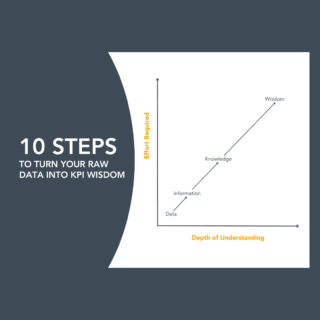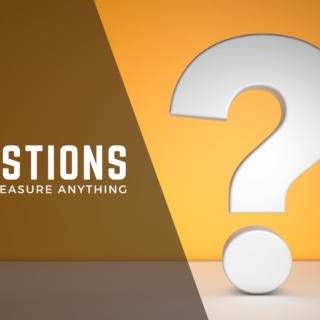Part 1 of 2
Tell me how you measure me, and I will tell you how I will behave”, said Eliyahu Goldratt, author of The Goal. So, you better make sure you not only measure often, but that you also measure well.
Why do so many people just see the dysfunction of measurement and not its true value?
It’s because they are unable to recognize its value proposition. The Leadership Institute states that a value proposition outlines, in as concrete and precise a way as possible, the value your product or service will create for the end-user. Below are 8 of the 17 value-drivers that make measurement such a differentiator of well-run organizations.
Value-driver 1: Measurement directs behaviour
Measures are like gravity. They pull our teams’ and leaders’ attention towards them. The attraction is so powerful that behaviour can be predicted based on what is being measured. So, be very careful what and how you measure. If you see teams taking actions that are driving low value outputs or downright damaging results, examine what is being measured or measured poorly or not measured at all. These unintended consequences are often a result of our dysfunctional measurement approach.
- Reflection: Can you think of one measure that is measuring the wrong thing, thus driving the wrong behaviour and wiping out the value? Can you spark a conversation to change it this month?
Value-driver 2: Measurement makes the invisible, visible
Leaders are too often blind to the performance of their organizational processes and capabilities. How can you see changes in “innovation, modernization, diversity, or sustainability” when it is not directly visible? You can’t manage what you can’t see, until measurement-done-well becomes our leaders’ and teams’ “eyes”. And this is measurement’s incredible value: quality feedback over time unlocks our vision and drives quantified improvement.
- Reflection: Do you have a proper KPI approach (like PuMP®) that allows your teams to meaningfully measure the less tangible, that gives those tasked with improving performance the visible truth from which to base their priorities?
Value-driver 3: Measurement focuses the attention of teams
Too many organizations exist in a whirlwind of activity, making employees feel overwhelmed and unsure where to focus their time and resources. In the absence of proper measurement, it is human nature to focus on what is comfortable, familiar or “the squeaky wheel” (vs strategic and change-oriented), even if it’s the wrong wheel. True value from measurement comes only by measuring what is most important to achieve. We want to quiet the activity for activity’s sake, by gaining the attention of our teams with the fewest, most meaningful measures that they are involved in designing.
- Reflection: Can you spot a KPI in your organization that is measuring a “squeaky wheel”, that is the “wrong” wheel, resulting in the diversion of important resources to low value activity?
Value-driver 4: Measurement clarifies expectations
The role of communicating expectations for their organization rests firmly on its leaders’ shoulders; but, too often, management goals are vague and fail to communicate clearly what is expected of their teams. Here are some real-life examples:
- “We want our supply chain to be more agile.”
- “Our services should be customer friendly.”
- “Government needs to innovate and modernize.”
You get 8 people in a room, and they will likely all have different interpretations of what is expected to be achieved!! Only well-defined quantified measures (with data you can trust) can cut through these fuzzy layers clearly and get right to the point of defining the expected level of performance they hope to achieve.
- Reflection: Can you think of an example in your organization where something important (eg. a goal, outcome, or objective) has unclear expectations of what success looks like, and it leaves people feeling confused (though they rarely say it out loud?).
Value-driver 5: Measurement enables accountability
Accountability is not a swear word, but it is often treated like one when it too closely links leaders’ performance to rewards for achieving targets, and punishment if they don’t. But let’s face it, most organizations would benefit from more accountability. So how do we reframe it? Dr. Dean Spitzer calls for“Positive Accountability”,simply the opportunity to perform and improve by applying measurement responsibly (ie. using measures for learning, not to avoid punishment or achieve rewards). Without proper performance measurement, there is no way to determine if whatever leaders and teams were supposed to achieve has been accomplished.
- Reflection: Do any leaders feel accountability is positive for your organization? Or is it mostly avoided? What is one step you could take to introduce this concept of “positive accountability” as an alternative to how people currently feel and show up around measurement?
Value-driver 6: Measurement increases objectivity
We can’t really say this enough: measurement’s true purpose is to drive learning and improvement within our organizations. When used for learning, people want to measure and use the data (objective facts) for better decision-making. But too often, poor measurement cultures make people feel judged, and no one likes being judged (especially on their subjective opinion). Measurement author Bob Frost says “Objective measurement enables us to manage by fact; without them, we’re left to lead with “charm and personality”. And charm and personality only go so far, when compared to the value of an objective measurement culture.
- Reflection: Can you identify a time in business when (1) you felt judged when a measure was being used to evaluate performance, and (2) you felt motivated by a measure? What was different? What is one thing you could change at work to have more measures that motivate?
Value-driver 7: Measurement provides the basis for target-setting
Typical approach to target-setting: Goal > Action >Target >Measure, but this makes no sense at all and drives leaders to guess at a numerical target before they even know how they will measure it. The SMART acronym is usually the culprit of so many rushed and meaningless targets. Instead, we need a logical approach: Goal > Measure (with data) > Target > Action. Remember leaders: you will get what you measure! So don’t get sucked into setting targets if you have not yet designed a meaningful measure that gives you evidence (trusted data) of something that really matters to improve in your organization.
- Reflection: Can you think of an important organizational goal with a target in your business that no one believes in (but no one says so) because it lacked a well-defined measure and scale when it was chosen. What is one thing you could do to improve target setting for this goal?
Value-driver 8: Measurement improves execution
Many leaders forget that the purpose of setting strategic direction is to achieve it. And even the greatest strategy in the world can be ruined by lackluster execution. You will never be able to execute well or consistently without proper measurement. Execution guru Larry Bossidy says in his book with the same name (Execution) “When I see companies that don’t execute well, the chances are that they don’t measure well either”.
- Reflection: Have you experienced a time when you tried to determine how you would execute on a goal when it didn’t have a measure? How might it have been easier if it had one? What might you do differently next time you are asked to execute a goal that doesn’t have a measure?
(Special thanks goes to Dean R. Spitzer, PhD, Author of Transforming Performance Measurement, 2007 for his generosity of knowledge and thought within the measurement space and with his permissions with Adura Strategy.)
Join us in October for PART 2: Measurement’s Value Proposition – Value Drivers 9-17



